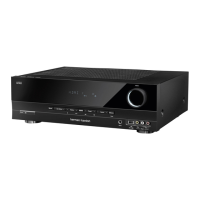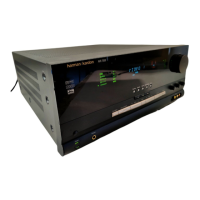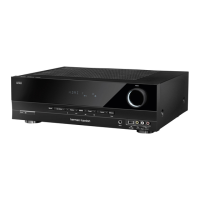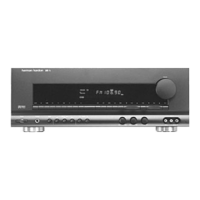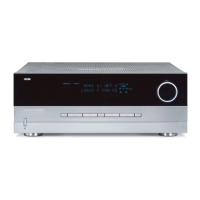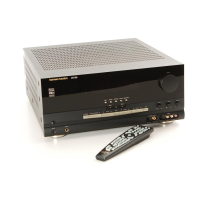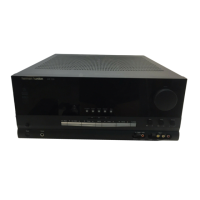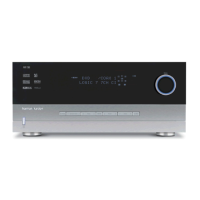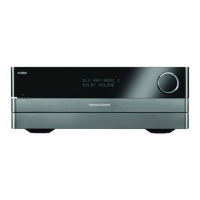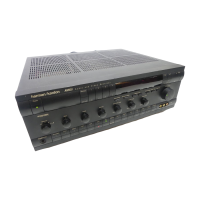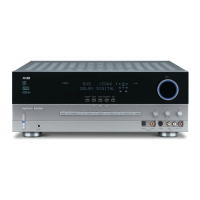
Do you have a question about the Harman Kardon AVR 700 and is the answer not in the manual?
| Channels | 5.1 |
|---|---|
| Type | AV Receiver |
| HDMI Inputs | 4 |
| HDMI Outputs | 1 |
| Wireless Connectivity | No |
| Total Harmonic Distortion | 0.07% |
| Input Sensitivity | 200mV |
| Signal-to-Noise Ratio | 100dB |
| Power Output | 75 watts per channel |
| Power Output Details | 75W per channel, 20Hz-20kHz, 0.07% THD, 8 ohms |
| Audio Formats Supported | Dolby Digital, Dolby TrueHD, DTS |
| Video Inputs | 4 HDMI, 2 Component, 2 Composite |
| Video Outputs | 1 Composite |
| Audio Inputs | Digital Optical: 2 |
Lists all items included with the AVR for initial setup and operation.
Critical safety precautions and warnings for using the AVR unit.
Recommendations for positioning the AVR for optimal performance, ventilation, and stability.
Description of the main power switch and standby/on button on the AVR's front panel.
Details on the message display screen and the IR sensor for remote control reception.
Buttons for choosing listening modes (Stereo, Surround) and input sources.
Controls for radio tuning, preset station management, and memory functions.
The physical knob for volume adjustment and the port for private headphone listening.
Interface for connecting USB storage devices and various audio/video input ports.
Terminals for AM/FM antennas and digital audio connections like coaxial and optical.
Ports for high-definition multimedia interface (HDMI) and composite video signals.
Jacks for analog audio signals and the dedicated connection for a powered subwoofer.
Connections for loudspeakers and the receptacle for the AC power cord.
Controls for powering the unit, muting audio, and selecting AVR control mode.
Buttons to select input sources, listening modes, and adjust tone controls.
Buttons for adjusting volume, changing display modes, and activating test tones.
Controls for accessing and navigating system setup menus and options.
Keypad for numeric input, station tuning, and preset selection for radio.
Utility buttons for sleep timer, display dimming, and media track navigation.
Port for USB devices and connector for private listening with headphones.
Description of the essential components that make up a home theater system.
Explanation of multichannel audio, speaker roles, and surround sound benefits.
Introduction to the various surround sound technologies and modes available.
Guidance on optimal placement for front left, center, and right speakers.
Instructions for correctly positioning surround left and right speakers.
Tips for locating the subwoofer to achieve the best bass response in the room.
Reference for the CEA color standard and analog audio connection types.
Detailed steps for connecting the subwoofer and individual speakers to the AVR.
Instructions for linking digital audio sources via HDMI and coaxial cables.
Methods for connecting video sources using composite and analog video ports.
How to connect sources using optical digital audio and standard stereo analog audio.
Information on using the USB port and connecting composite video sources.
Step-by-step guide for wiring speakers and connecting the subwoofer.
Instructions for linking the AVR output to your television or monitor.
Comprehensive guide to connecting all types of audio/video source components.
Guidance on connecting high-definition digital audio and video sources.
Instructions for connecting composite video, coaxial digital audio, and analog audio devices.
How to connect analog recorders for playback and recording purposes.
Instructions for attaching FM and AM antennas for optimal radio reception.
Procedure for inserting batteries into the remote control for initial use.
Steps to turn on the AVR and enter the system setup menu.
How to use the remote control to navigate and configure the AVR via the TV display.
Setting speaker types, sizes, and crossover frequencies for optimal sound.
Adjusting crossover points and speaker distances for accurate sound staging.
Using test tones to set individual speaker volume levels for a balanced sound field.
Configuration of HDMI ARC/CEC, audio settings, and auto power management.
Methods for adjusting audio volume and temporarily silencing the sound output.
Instructions for enabling private listening using headphones connected to the AVR.
How to choose between different input sources for audio and video playback.
Guide to tuning stations, using presets, and listening to radio broadcasts.
Instructions for connecting and playing MP3 and WMA files from a USB drive.
Choosing and fine-tuning various surround sound modes for different content.
Details on how analog and digital audio signals are processed for surround sound.
Method for adjusting individual speaker volumes for personalized sound balance.
Guidance on connecting recorders to capture audio and video from sources.
How to set the AVR to automatically turn off after a desired period.
Procedure for resetting the AVR to factory default settings to resolve issues.
Information about how user configurations are saved during power interruptions.
Solutions for the AVR not turning on or experiencing issues with the front panel display.
Troubleshooting steps for lack of audio output or protection mode activation.
Resolving issues with the remote control's responsiveness or tuner performance.
Detailed technical data for the AVR's audio amplification and video processing capabilities.
Specifications related to the frequency range, sensitivity, and signal-to-noise ratio of the tuners.
Information on power requirements, consumption, physical dimensions, and weight.
A table outlining optimal connection types for various source devices.
Templates for documenting individual speaker settings and channel configurations.
Templates for logging speaker volume levels and distances from the listening position.
Explanations of Dolby Digital Plus, TrueHD, and various DTS modes.
Details on DTS-HD formats and their compatibility with high-definition sources.
Descriptions of DTS Stereo and DTS Neo:6 cinema and music modes.
Information on Theater, Hall, Stadium, Club, and Arena surround sound effects.
Details on 5-Channel Stereo and 2-Channel Stereo listening options.
Reference list of remote buttons and their functions for controlling the AVR.
List of remote buttons and their functions when operating a compatible Blu-ray or DVD player.
